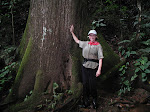
Now, just sit down there, senora, and I’ll show you how it’s done!
Yaneth then shows me how to make tortillas, Salvadoran style.
Everything I try to do in the kitchen, Yaneth can improve on it. Her latest batch of orange marmalade is the best yet out of El Tigre!
Many plants are blooming and fruiting earlier than usual this season - species of Asteracea, Fabaceae, Malvaceae, Rubaceae, Myrtaceae and others.
Bernoullia flammea (F.Bombacac) are currently in full bloom all over Reserva El Tigre. We’ve had enough rain to keep the ground moist, thankfully, but not the drenching rains normally expected at this time of the year in Costa Rica. Clouds descend as mist on the forest at night, cooling everything down. In fact, temperatures are cooler than usual, which helps mitigate the drier season.
Still, we decided to postpone any further planting until the start of rainy season, next May 2010.
And now to the point. Why plant at all, when nature does so much of the work for us? It’s taken me years of gardening to realize that the most beautiful and healthiest plants seed themselves right where they need to be. No matter how beautiful your garden, nature will improve it - if you can recognize the treasures popping up all around. Why are you weeding out everything? Why are you battling with plants that want to grow there! Take a close look at what’s popping up all around your prized Cordylines and, in many cases, you will find good company for your garden plants. If you let some of the natives grow, you will find that your cultivars now combine gracefully with the native volunteers. At a certain point - at least, this is what happened to me - you have this insight that the native plants look more, well, natural and beautiful in the garden, and the cultivars start to look out of place. And you get the urge to remove plants that you bought in a garden nursery.
I think most tropical gardeners - those living close to a forest - go through this transformation sooner or later. You start out by designing gardens and buying plants. Then you notice how the native plants popping up seem to accompany and ‘help’ the purchased cultivars. During times of drought, the natives hold up much better and so you start to expand the natives - going with the flow. Soon, you begin to identify native species in the forest that look much sturdier than the cultivars of the same Genus you bought in La Garita. This has happened to me over and over again. Armando has found species of Lantana, Morning Glory, Justicia, Hibiscus, palms, ferns and many others growing in the El Tigre forest, and we’ve brought clippings up to the gardens to see how they fare. They do well. Better, in fact, than the cultivars bought in the garden centers.
Take a look at this lovely Petrea species we brought up from the forest.

This native vine usually climbs high into the trees but we got a hold of this clipping for the garden.
The plants that do best of all are the volunteers that seed themselves.
Here’s a shot of a Cecropia that popped up in the garden below the pool.

This volunteer has transformed the garden. You can walk right up and see the visiting birds eye to eye.
Here’s a Montanoa species, one of many ‘Tora’ species in flower now at El Tigre.

This one is a sweet, vanilla-smelling variety.
We recently dumped a truckload of red volcanic rock at the edge of the driveway to stabilize the area. Normally, a gardener would think, “Let’s design and plant a rock garden”. But not us, not now. We just waited to see what would pop up there naturally. It didn’t take long. Soon we began observing ferns and mosses taking hold in the rocky crevices.
Take a look at the first fern to pop up:

What will be growing there in a few more years? The retaining rock walls around the house hold clues.

An incredible diversity of plant life nestles amidst the rocks, much of which goes dormant during the dry season, but which provides a lush carpet for the walls.
Many forest plants also have important culinary or medicinal properties. You can eat the leaves and flowers of the nutritious Hibiscus plant, but the natives are the sweetest and most sought after by the hummingbirds. And by humans too!
Take a look at a few charming Malvaceaes in bloom now at El Tigre:



Here’s a shot of Armando tasting his favorite Malvac. He calls it Amapola.

There are so many native edibles! Here’s a shot of one of the Passiflora species growing on the fence row.

We do also cultivate native, edible fruits, grains and vegetables. Here’s a shot of Danny with the latest crop of frijoles.

And yes, we still have a place for exotics in the garden - especially the edibles!
Here’s a shot of tea - Camellia sinensis - in flower:

Here’s our very first fig - Gerry’s favorite fruit:

Edibles aside, we have awakened to the natives in the natural world. The forest reaches up to the gardens, mixing and merging. And, inexorably, the Exotics decline as the sturdier natives move up.




















